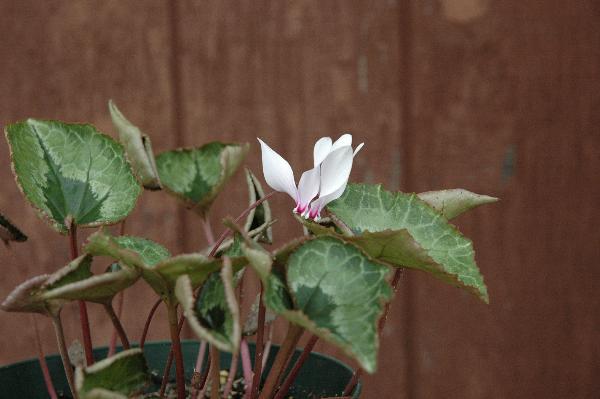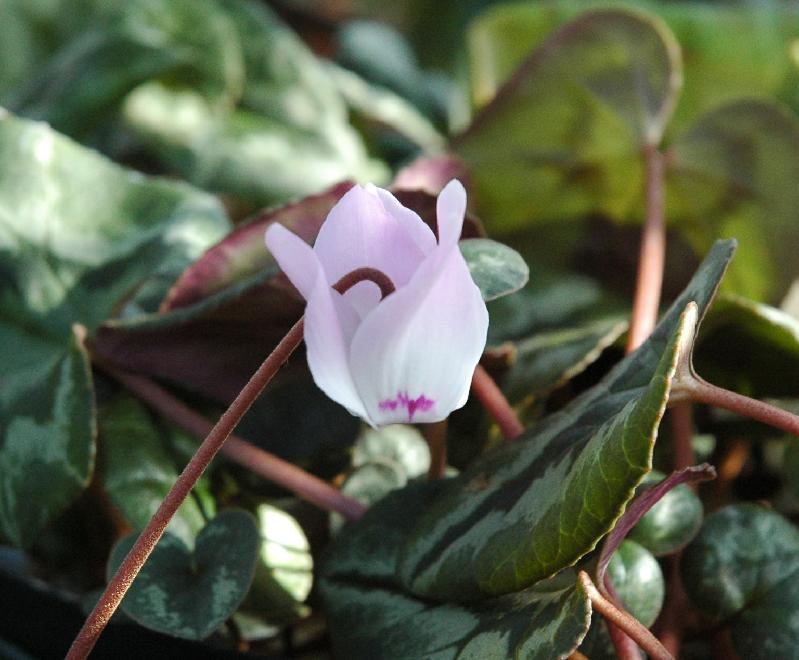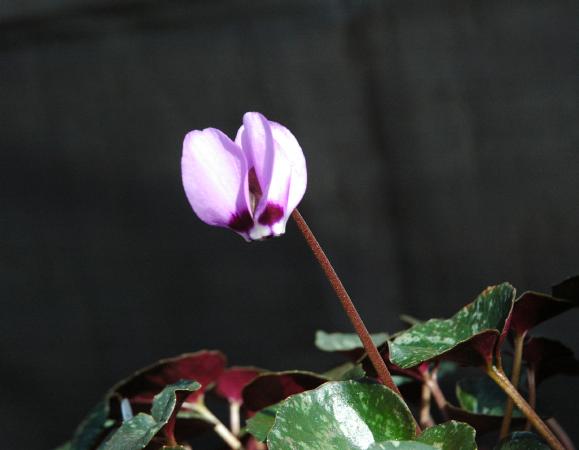CYCLAMEN
Cyclamen is a genus in the Primula Family, Primulaceae. It is native to the Mediterranean basin, parts of Europe, and the Caucasus. The flowers vary from white to deep, rich rose in color. The leaves vary widely in shape, from round to heart-shaped to ivy shaped to arrow-like, and may be plain dark green or decorated with intricate silver patterns. The plants reproduce readily from seed, so there are no named clones of the wild species although many seed strains are passed from gardener to gardener.
The florists' cyclamen are all derived from the species Cyclamen persicum. They are huge compared to the wild species. I suspect they are propagated by tissue culture techniques, and I won't deal with any of them here.
It is an unusual genus in that almost all its members undergo summer dormancy or aestivation. As a result, they are not well suited to growing in the Midwest with its hot, humid, and usually very wet summers.
Except for one brief mention of Cyclamen hybrids in November 2009, I think I have not mentioned this group of plants in this blog. I've grown some of the species of Cyclamen in the past, so I'll talk a bit about them now. This is a pretty dull time of year for flowers, and is therefore a good to time review a genus I have been neglecting.
In fact, I have let my collection of Cyclamen dwindle in recent years, but I'm getting ready to try to build it back up a bit. There is much to be said for occasionally cleaning up the potting bench. I ran across some seeds of cyclamen varieties sent to me by friends over the past year's time, and this got me to planting them. And about time, too!
Common Species
The commonest and the hardiest species are probably coum, hederifolium, and purpurascens. These tolerate or even need some summer moisture, and survive cold winters in Europe.
C. coum is native to the region from Bulgaria through Turkey to the Caucasus and Israel. The leaves are simple round or heart-shaped, the flowers pink with a red nose. It blooms in autumn. The tubers are supposed to be fairly hardy, but the squirrels around here really love them; they must be tasty.
C. hederifolium is native to most of southern Europe and is widely naturalized elsewhere in Europe. The leaves are varied in shape and coloration, with round shapes, arrow shapes, and others. There are forms that have intricate patterns in silver on the leaves. This species produces roots only from the upper surface of the tubers. The flowers appear from mid-summer into autumn, and vary in color from white to rich carmine. An obsolete synonym for this species is Cyclamen neapolitanum.
C. purpurascens occurs widely in the Alps, northern Italy, and the former Yugoslavia. The leaves are round, plain green or with a slight pattern, and the flowers appear from late summer into autumn. Flowers are light to deep rose in color. This is the hardiest species; but it can be difficult to establish in the garden, as I can attest from personal experience.
More Exotic Species
Here are some of the less common species. Most of these are also much less hardy in cold climates, as far as I know. I would grow these only inside a greenhouse or in a cool, bright window.
C. africanum is native to North Africa, and superficially resembles hederifolium very strongly. It must be kept dry in summer, and blooms in autumn, usually as soon as you start watering it again.

Cyclamen africanum
C. cilicicum from Turkey blooms in the autumn. The flowers are light pink with a deep pink eye at the base of the petals.
C. graecum is native to Greece and the Greek islands and near-by parts of Turkey. It needs a dry rest and survives baking and totally dry storage in the greenhouse over summer. The leaves are large and may be marked with patterns of silver. Blooms in early autumn, sometimes starting before I resume watering. The roots grow from the bottom of the tuber and are fleshy and contractile, capable of pulling the tubers deeply into the soil.
C. intaminatum occurs locally in western Turkey. It is much less common in cultivation than any of the above species. This is one of the smallest species of Cyclamen, with only parviflorum being smaller. The flowers appear in autumn. The flowers are white or light pink, with very distinctive veins in the petals.
C. libanoticum is native to Lebanon. The mottled leaves are deep purple on the underside. The large flowers are white to pink and appear in late winter. Must be kept frost-free, according to some books.

Cyclamen libanoticum
C. pseudibericum is almost extinct in the wild. It comes from southern Turkey. The large flowers come up in spring. The leaves have a red underside. The roots grow from the base of the tuber.

Cyclamen pseudibericum
C. repandum is native to southern France and southern Switzerland to Italy and Bosnia, Corsica, and Sardinia. The leaves are light green with dark green mottling; they are red on the underside. The flowers are carmine with a deeper rose nose.
C. trochopteranthum - the propeller shaped flower - is found in southwestern Turkey. The unusual pinwheel flowers appear in spring.
There are plenty of other species, and numerous subspecies in addition to those I mentioned here. I recommend Christopher Grey-Wilson's book, Cyclamen, published in 1997 by Timber Press. There is also a nice section on Cyclamen in "Bulbs" Revised edition, by John E. Bryan, pub. by Timber Press in 2002.
Rebuilding my Collection
Pamela in the Pacific Northwest sent me some tiny seedling bulbs of Cyclamen hederifolium. There seemed to be quite a lot of them, so I simply spread the mixture of little bulbs, their dried-up roots, and the brown peat in which they had been packed. They went on the surface of my gritty mix in one 10-inch diameter by 5 inches deep round plastic bulb pan. I then covered them with a layer of brown sand and set the pot in a tub of water up to the surface of the mix. The pot went into the greenhouse once the medium was thoroughly soaked.
Next I came across a nice batch of very dry seeds of Cyclamen "rhodense" which according to the ARS-GRIN database is Cyclamen peloponnesiacum ssp. rhodense. It is also called C. repandum rhodense and is so listed in Christopher Grey-Wilson's book, "Cyclamen." Both forms of the name are listed in IPNI. In the Kew Plant List the preferred name is given as C. repandum subsp. rhodense (Meikle) Grey-Wilson.
I planted these seeds pretty much the same way as I did the small hederifolium seedling bulbs, in the same medium in the same size pot.
Next come a very few seeds of Cyclamen intaminatum and later a large batch of seeds from select plants of Cyclamen purpurascens. I have had the purpurascens in the past, but eventually lost them. In my climate, they really need to go outdoors in the ground in a protected spot. They need some moisture in summer and can supposedly take some freezing temperatures in winter. I will simply have to find the right spot for them, and then plant them deeply enough that they survive the cold winters.
My plants of various forms of Cyclamen graecum, from seed given to me years ago by Joy Bishop, survive the summers here in the greenhouse, very hot and very dry, and no water. Cyclamen africanus does just as well under the same conditions. Every other form of Cyclamen I've treated to this type of summer conditions has dried up and died on me. On the other hand, Cyclamen in containers left outdoors over summer, in shade but exposed to natural rainfall, have gradually rotted away over two or three such summers. Most forms need a middle way to survive the summers here.
I have probably mentioned in the past that Cyclamen coum and C. hederifolium planted outdoors in the ground here have survived for a few years, but never bloomed. Most of the coum were stolen by squirrels the first winter. So I think that one will have to plant coum, hederifolium, and purpurascens outdoors, plant them deep - 6 inches - and treat them very carefully, to grow them outdoors in the Midwest. It is certainly worth a try.
Good gardening, from here in central Indiana
Jim
<shieldsgardens@gmail.com>
Look up technical terms in the Glossary of Plant Biology